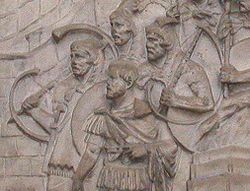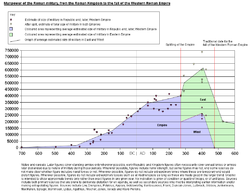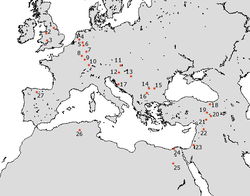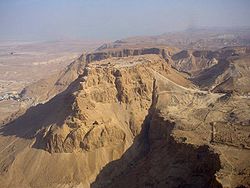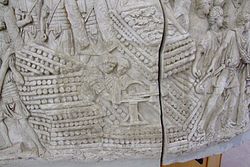- Military of ancient Rome
-

This article is part of the series on:
Military of ancient Rome (portal)
753 BC – AD 476Structural history Roman army (unit types and ranks, legions, auxiliaries, generals) Roman navy (fleets, admirals) Campaign history Lists of wars and battles Decorations and punishments Technological history Military engineering (castra, siege engines, arches, roads) Political history Strategy and tactics Infantry tactics Frontiers and fortifications (limes, Hadrian's Wall) The Roman military was intertwined with the Roman state much more closely than in a modern European nation. Josephus describes the Roman people being as if they were "born ready armed."[1] and the Romans were for long periods prepared to engage in almost continuous warfare, absorbing massive losses. For a large part of Rome's history, the Roman state existed as an entity almost solely to support and finance the Roman military.
The military's campaign history stretched over 1300 years and saw Roman armies campaigning as far East as Parthia (modern-day Iran), as far south as Africa (modern-day Tunisia) and Aegyptus (modern-day Egypt) and as far north as Britannia (modern-day England, Scotland, and Northeast Wales). The makeup of the Roman military changed substantially over its history, from its early history as an unsalaried citizen militia to a later professional force. The equipment used by the military altered greatly in type over time, though there were very few technological improvements in weapons manufacture, in common with the rest of the classical world. For much of its history, the vast majority of Rome's forces were maintained at or beyond the limits of its territory, in order to either expand Rome's domain, or protect its existing borders.
Contents
Personnel
At its territorial height, the Roman Empire may have contained between 45 million and 120 million people.[2] Historian Edward Gibbon estimated that the size of the Roman army "most probably formed a standing force of 3,750,000" men at the Empire's territorial peak in the time of the Roman Emperor Hadrian. This estimate probably included only legionary and auxiliary troops of the Roman army.[3] However, Gibbon states that it is "not... easy to define the size of the Roman military with any tolerable accuracy." In the late Imperial period, when vast numbers of foederati were employed by the Romans, Antonio Santosuosso estimated the combined number of men in arms of the two Roman empires numbered closer to 700,000 in total (not all members of a standing army), drawing on data from the Notitia Dignitatum. However, he notes that these figures were probably subject to inflation due to the practice of leaving dead soldiers "on the books" in order to continue to draw their wage and ration. Furthermore, it is irrespective of whether the troops were raised by the Romans or simply hired by them to fight on their behalf.[4]
There is no archaeological evidence that suggests that women constituted a significant proportion of troops even amongst the federated troops of the late empire. For the majority of its history, the Roman army was open to male recruits only, and for a greater part of that history only those classified as Roman citizens (as opposed to allies, provincials, freedmen and slaves) were eligible for military service.
Initially, Rome's military consisted of an annual citizen levy performing military service as part of their duty to the state. During this period, the Roman army would prosecute seasonal campaigns against largely local adversaries. As the extent of the territories falling under Roman suzerainty expanded, and the size of the city's forces increased, the soldiery of ancient Rome became increasingly professional and salaried. As a consequence, military service at the lower (non-staff) levels became progressively longer-term. Roman military units of the period were largely homogeneous and highly regulated. The army consisted of units of citizen infantry known as legions (Latin: legiones) as well as non-legionary allied troops known as auxilia. The latter were most commonly called upon to provide light infantry or cavalry support.
Military service in the later empire continued to be salaried and professional for Rome's regular troops. However, the trend of employing allied or mercenary troops was expanded such that these troops came to represent a substantial proportion of Rome's forces. At the same time, the uniformity of structure found in Rome's earlier military forces disappeared. Soldiery of the era ranged from lightly armed mounted archers to heavy infantry, in regiments of varying size and quality. This was accompanied by a trend in the late empire of an increasing predominance of cavalry rather than infantry troops, as well as a requital of more mobile operations.
Military Culture
Historian Peter Heather describes Roman military culture as being "just like the marines, but much nastier".[5] In the legions of the Republic, discipline was fierce and training harsh, all intended to instill a group cohesion or esprit de corps that could bind the men together into effective fighting units. Unlike opponents such as the Gauls, who were fierce individual warriors, Roman military training concentrated on instilling teamwork and maintaining a level head over individual bravery - troops were to maintain exact formations in battle and "despise wild swinging blows"[6] in favour of sheltering behind one's shield and delivering efficient stabs when an opponent made himself vulnerable.
Loyalty was to the Roman state but pride was based in the soldier's unit, to which was attached a military standard - in the case of the legions a legionary eagle. Successful units were awarded with accolades that became part of their official name, such as the 20th legion, which became the XX Valeria Victrix (the "Valiant and Victorious 20th").
Of the martial culture of less valued units such as sailors, and light infantry, less is known, but it is doubtful that its training was as intense or its esprit de corps as strong as in the legions.
Funding and expenditures
See also: Roman economy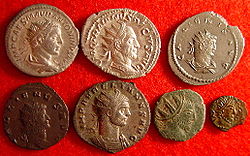 Roman coins grew gradually more debased due to the demands placed on the treasury of the Roman state by the military
Roman coins grew gradually more debased due to the demands placed on the treasury of the Roman state by the military
Although early in its history troops were expected to provide much of their own equipment, eventually the Roman military was almost entirely funded by the state. Since soldiers of the early Republican armies were also unpaid citizens, the financial burden of the army on the state was minimal. However, since the Roman state did not provide services such as housing, health, education, social security and public transport that are part and parcel of modern states, the military always represented by far the greatest expenditure of the state.[7]
During the time of expansion in the Republic and early Empire, Roman armies had acted as a source of revenue for the Roman state, plundering conquered territories, displaying the massive wealth in triumphs upon their return and fueling the economy[8] to the extent that historians such as Toynbee and Burke believe that the Roman economy was essentially a plunder economy. However, after the Empire had stopped expanding in the 2nd century, this source of revenue dried up; by the end of the 3rd century, Rome had "ceased to vanquish."[9] As tax revenue was plagued by corruption and hyperinflation during the Crisis of the Third Century, military expenditures began to become a "crushing burden"[10] on the finances of the Roman state.[11] It now highlighted weaknesses that earlier expansion had disguised. By 440, an imperial law frankly states that the Roman state has insufficient tax revenue to fund an army of a size required by the demands placed upon it.[12]
Several additional factors bloated the military expenditure of the Roman Empire. Firstly, substantial rewards were paid for the demeanor of "barbarian" chieftains in the form of negotiated subsidies and for the provision of allied troops.[13] Secondly, the military boosted its numbers, possibly by one third in a single century.[7] Finally, the military increasingly relied on a higher ratio of cavalry units in the late Empire, which were many times more expensive to maintain than infantry units.[14]
While military size and costs increased, new taxes were introduced or existing tax laws reformed in the late Empire in order to finance it frequently. Although more inhabitants were available within the borders of the late Empire, reducing the per capita costs for an increased standing army was impractical. A large number of the population could not be taxed because they were slaves or held Roman citizenship, which exempted them from taxation in one way or another.[15] Of the remaining, a large number were already impoverished by centuries of warfare and weakened by chronic malnutrition. Still, they had to handle an increasing tax rate[16] and so they often abandoned their lands to survive in a city.[17]
Of the Western Empire's taxable population, a larger number than in the East could not be taxed because they were "primitive subsistence peasant[s]"[17] and did not produce a great deal of goods beyond agricultural products. Plunder was still made from suppressing insurgencies within the Empire and on limited incursions into enemy land. Legally, much of it should have returned to the Imperial purse, but these goods were simply kept by the common soldiers, who demanded it of their commanders as a right. Given the low wages and high inflation in the later Empire, the soldiers felt that they had a right to acquire plunder.[18][19]
Capabilities
Readiness and Disposition
The military capability of Ancient Rome – its military preparedness or readiness – was always primarily based upon the maintenance of an active fighting force acting either at or beyond its military frontiers, something that historian Luttwak refers to as a "thin linear perimeter."[20] This is best illustrated by showing the dispositions of the Roman legions, the backbone of the Roman army. (see right). Because of these deployments, the Roman military did not keep a central strategic reserve after the Social War. Such reserves were only re-established during the late Empire, when the army was split into a border defense force and mobile response field units.
Power projection
The Roman military was keen on the doctrine of power projection – it frequently removed foreign rulers by force or intimidation and replaced them with puppets. This was facilitated by the maintenance, for at least part of its history, of a series of client states and other subjugate and buffer entities beyond its official borders, although over which Rome extended massive political and military control. On the other hand, this also could mean the payment of immense subsidies to foreign powers[13] and opened the possibility of extortion in case military means were insufficient.
Sustainability
The Empire's system of building an extensive and well-maintained road network, as well as its absolute command of the Mediterranean for much of its history, enabled a primitive form of rapid reaction, also stressed in modern military doctrine, although because there was no real strategic reserve, this often entailed the raising of fresh troops or the withdrawing of troops from other parts of the border. However, border troops were usually very capable of handling enemies before they could penetrate far into the Roman hinterland.
The Roman military had an extensive logistical supply chain. There was no specialised branch of the military devoted to logistics and transportation, although this was to a great extent carried out by the Roman Navy due to the ease and low costs of transporting goods via sea and river compared to over land.[21] There is archaeological evidence that Roman armies campaigning in Germania were supplied by a logistical supply chain beginning in Italy and Gaul, then transported by sea to the northern coast of Germania, and finally penetrating into Germania via barges on inland waterways. Forces were routinely supplied via fixed supply chains, and although Roman armies in enemy territory would often supplement or replace this with foraging for food or purchasing food locally, this was often insufficient for their needs: Heather states that a single legion would have required 13.5 tonnes of food per month, and that it would have proved impossible to source this locally.[22]
Policing
For the most part, Roman cities had a civil guard used for maintaining the peace. Due to fears over rebellions and other uprisings, they were forbidden to be armed up to militia levels. Policing was split between the civil guard for low-level affairs and the Roman legions and auxilia for suppressing higher-level rioting and rebellion. This created a limited strategic reserve, one that fared poorly in actual warfare.
Engineering
The military engineering of Ancient Rome's armed forces was of a scale and frequency far beyond that of any of its contemporaries. Indeed, military engineering was in many ways institutionally endemic in Roman military culture, as demonstrated by the fact that each Roman legionary had as part of his equipment a shovel, alongside his gladius (sword) and pila (spears). Heather writes that "Learning to build, and build quickly, was a standard element of training".[23]
This engineering prowess was, however, only evident during the peak of Roman military prowess under the mid-Republic to the mid-Empire. Prior to the mid-Republic period there is little evidence of protracted or exceptional military engineering, and in the late Empire likewise there is little sign of the kind of engineering feats that were regularly carried out in the earlier Empire.
Roman military engineering took both routine and extraordinary forms, the former a proactive part of standard military procedure, and the latter of an extraordinary or reactionary nature. Proactive military engineering took the form of the regular construction of fortified camps, in road-building, and in the construction of siege engines. The knowledge and experience learned through such routine engineering lent itself readily to any extraordinary engineering projects required by the army, such as the circumvallations constructed at Alesia and the earthen ramp constructed at Masada.
This engineering expertise practiced in daily routines also served in the construction of siege equipment such as ballistae, onagers and siege towers, as well as allowing the troops to construct roads, bridges and fortified camps. All of these led to strategic capabilities, allowing Roman troops to, respectively, assault besieged settlements, move more rapidly to wherever they were needed, cross rivers to reduce march times and surprise enemies, and to camp in relative security even in enemy territory.
International stance
Rome was established as a nation making aggressive use of its high military potential. From very early on in its history it would raise two armies annually to campaign abroad. Far from the Roman military being solely a defence force, for much of its history, it was a tool of aggressive expansion. Notably, the Roman army had derived from a militia of mainly farmers, and gaining new farming lands for the growing population or later retiring soldiers was often one of the campaigns' chief objectives. Only in the late Empire did the Roman military's primary role become the preservation of control over its territories. Remaining major powers next to Rome were the Kingdom of Aksum, Parthia and the Hunnic Empire. Knowledge of China, the Han Dynasty at the times of Mani, existed and it is believed that Rome and China swapped embassies in about 170.[24]
Grand strategy
In its purest form, the concept of strategy deals solely with military issues. However, Rome is offered by Edward Luttwak and others as an early example of a state that possessed a grand strategy which encompassed the management of the resources of an entire nation in the conduct of warfare. Up to half of the funds raised by the Roman state were spent on its military, and the Romans operated a system of grand strategy that was clearly more complicated than simple knee-jerk strategic or tactical responses to individual threats. Rome's grand strategy changed over time, implementing different systems to meet different challenges and reflecting changing internal priorities, but elements of Rome's grand strategy included client states, the deterrent of armed response in parallel with manipulative diplomacy, and a fixed system of troop deployments and road networks. Luttwak states that there are "instructive similarities" between Roman and modern military strategy.[25]
Campaigns
Initially, Rome's military consisted of an annual citizen levy performing military service as part of their duty to the state. During this period, the Roman army would prosecute seasonal campaigns against its tribal neighbours and Etruscan towns within Italy. As the extent of the territories falling under Roman suzerainty expanded, and the size of the city's forces increased, the soldiery of ancient Rome became increasingly professional and salaried. As a consequence, military service at the lower (non-staff) levels became progressively longer-term. Roman military units of the period were largely homogeneous and highly regulated. The army consisted of units of citizen infantry known as legions (Latin: legiones) as well as non-legionary allied troops known as auxilia. The latter were most commonly called upon to provide light infantry or cavalry support.
Rome's forces came to dominate much of the Mediterranean and further afield, including the provinces of Britannia and Asia at the Empire's height. They were tasked with manning and securing the borders of the provinces brought under Roman control, as well as Italy itself. Strategic-scale threats were generally less serious in this period, and strategic emphasis was placed on preserving gained territory. The army underwent changes in response to these new needs and became more dependent on fixed garrisons than on march-camps and continuous field operations. In the late Empire, military service continued to be salaried and professional for Rome's regular troops. However, the trend of employing allied or mercenary troops was expanded such that these troops came to represent a substantial proportion of Rome's forces. At the same time, the uniformity of structure found in Rome's earlier military forces disappeared. Soldiery of the era ranged from lightly armed mounted archers to heavy infantry, in regiments of varying size and quality. This was accompanied by a trend in the late empire of an increasing predominance of cavalry rather than infantry troops, as well as a requital of more mobile operations.
Equipment
Although Roman iron-working was enhanced by a process known as carburization, the Romans are not thought to have developed true steel production. From the earliest history of the Roman state to its downfall, Roman arms were therefore uniformly produced from either bronze or, later, iron. As a result the 1300 years of Roman military technology saw little radical change in technological level. Within the bounds of classical military technology, however, Roman arms and armor was developed, discarded, and adopted from other peoples based on changing methods of engagement. It included at various times stabbing daggers and swords, stabbing or thrusting swords, long thrusting spears or pikes, lances, light throwing javelins and darts, slings, and bow and arrows[26].
Roman military personal equipment was produced in large numbers to established patterns and used in an established way. It therefore varied little in design and quality within each historical period. According to Hugh Elton, Roman equipment[27] (especially armor) gave them "a distinct advantage over their barbarian enemies." [28] who were often, as Germanic tribesmen, completely unarmoured. However, Luttwak points out that whilst the uniform possession of armour gave Rome an advantage, the actual standard of each item of Roman equipment was of no better quality than that used by the majority of its adversaries.[29] The relatively low quality of Roman weaponry was primarily a function of its large-scale production, and later factors such as governmental price fixing for certain items, which gave no allowance for quality, and incentivised cheap, poor-quality goods.
The Roman military readily adopted types of arms and armour that were effectively used against them by their enemies. Initially Roman troops were armed after Greek and Etruscan models, using large oval shields and long pikes. On encountering the Celts they adopted much Celtic equipment and again later adopted items such as the gladius from Iberian peoples. Later in Rome's history, it adopted practices such as arming its cavalry with bows in the Parthian style, and even experimented briefly with niche weaponry such as elephants and camel-troops.
Besides personal weaponry, the Roman military adopted team weaponry such as the ballista and developed a naval weapon known as the corvus, a spiked plank used for affixing and boarding enemy ships.
See also
References
Citations
- ^ Williamson, G. (tr.), Josephus, The Jewish War, 1959, p. 378
- ^ Estimates range wildly because census data was imprecise and there is some disagreement over how many federated tribes had settled permanently in Roman lands during the Mid to latte Empire.
- ^ Gibbon E., The Decline and Fall of the Roman Empire, Penguin, 1985, para. 65
- ^ Santosuosso, p. 188
- ^ Heather, P., The Fall of the Roman Empire, MacMillan, 2005, p. 6
- ^ Heather, P., The Fall of the Roman Empire, MacMillan, 2005, p.6
- ^ a b Heather, P., The Fall of the Roman Empire, MacMillan, 2005, p. 64
- ^ Caesar is said to have spent "huge portions of the wealth he accumulated in his victorious wars... on celebrating Triumphs... [and] on erecting magnificent buildings". Grant, p. 194
- ^ Gibbon, p. 199
- ^ Santosuosso, p. 214
- ^ Jones, p. 1041
- ^ Heather, p. 297
- ^ a b Hadas, M, et al., Imperial Rome, in Great Ages of man: A History of the World's Cultures, New York, Time-Life Books, 1965
- ^ Jones, AHM, The Later Roman Empire 284-602, Johns Hopkins University Press, 1964, p.1035
- ^ Including the millions of citizens of Rome
- ^ Edward Gibbon relates that "the fertile... province of Campania...was [w]ithin sixty years of the death of Constantine... granted [an exemption from tax amounting to] three hundred and fifty thousand... acres of desert and uncultivated land" - Gibbon, p. 376
- ^ a b Santosuosso A., Soldiers, Emperors and Citizens in the Roman Empire, Westview, 2001, p. 214
- ^ Grant, M., The History of Rome, Fabre and Faber, 1993, p. 287
- ^ Heather, P., The Fall of the Roman Empire, MacMillian, 2005, p. 29
- ^ Luttwak, p. 80
- ^ Luttwak notes that Roman troops could march roughly 15 miles per day over long distances, while ships could carry them far more economically and at speeds of 27-81 miles per day. - Luttwak, p. 81
- ^ Heather, P., The Fall of the Roman Empire, MacMillan, 2005, p. 55
- ^ Heather, P., The Fall of the Roman Empire, MacMillan, 2005, p. 7
- ^ Fan Ye, Xiyu chuan ("Chapter on the Western Regions"), in Hou Han shu (Official history of the Later Han Dynasty), ch. 88.
- ^ Luttwak, p. 1
- ^ Sims, Lesley: "The Roman Soldier's Handbook", page 17. Published, 2005.
- ^ Sims, Lesley: "The Roman Soldier's Handbook", page 38-31. Published, 2005.
- ^ Elton, Hugh, 1996, Warfare in Roman Europe, AD 350-425, p. 110
- ^ In Luttwack, E., The Grand Strategy of the Roman Empire, JHUP, 1979, Luttwack states that "Roman weapons, far from being universally more advanced, were frequently inferior to those used by... enemies
Bibliography
- Primary sources
- Livy, From the Founding of the City on Wikisource (print: Book 1 as The Rise of Rome, Oxford University Press, 1998, ISBN 0-19-282296-9).
- Polybius: The Rise of the Roman Empire at LacusCurtius (print: Harvard University Press, 1927. (Translation by W. R. Paton).
- Tacitus: The Annals.
- Secondary sources
- Edward Gibbon: The Decline and Fall of the Roman Empire (print: Penguin Books, 1985, ISBN 0-14-043189-6).
- Peter Connolly, Greece and Rome at War, Greenhill Books, 1998, ISBN 978-1-85367-303-0.
- Adrian Goldsworthy, In the Name of Rome: The Men Who Won the Roman Empire, Weidenfield and Nicholson, 2003, ISBN 0-297-84666-3.
- Michael Grant, The History of Rome, Faber and Faber, 1993, ISBN 0-571-11461-X.
- Peter Heather, The Fall of the Roman Empire: A New History, Macmillan Publishers, 2005, ISBN 0-330-49136-9.
- Arnold Hugh Martin Jones, The Later Roman Empire, Johns Hopkins University Press, 1964, ISBN 0-8018-3285-3.
- Robin Lane Fox, The Classical World, Penguin Books, 2005, ISBN 0-14-102141-1
- Edward Luttwak, The Grand Strategy of the Roman Empire, Johns Hopkins University Press, ISBN 0-8018-2158-4.
- Philip Matyszak, The Enemies of Rome, Thames and Hudson, 2004, ISBN 0-500-25124-X.
- Antonio Santosuosso, Storming the Heavens: Soldiers, Emperors and Civilians in the Roman Empire, Westview Press, 2001, ISBN 0-8133-3523-X.
External links
Categories:
Wikimedia Foundation. 2010.

